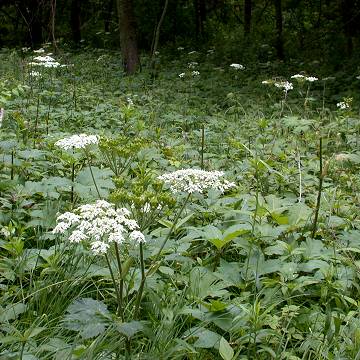

Heracleum maximum - (image 1 of 7)
Taxonomy
Family: Apiaceae
Habitat
Woodlands, shaded floodplains.
Associates
In disturbed woods with Acer saccharum, Crataegus mollis, Fraxinus ameicana, Parthenocissus quinquefolia, Prunus virginiana, Ribes missouriense, Sambucus canadensis, Ulmus americana, Vitis riparia.
Distribution
Most of the the US except the southern Midwest and parts of the southeast.
Morphology
Large, robust perennial to 10'. Leaves deeply 3-lobed or divided into 3 maple-like segments, with an inflated sheath at the base of the leaf stalk. Stems densely white, wooly hairy. Flowers white, petals notched, sometimes tinged purple, in robust umbels.
Notes
Flowers mid May to early July
Wetland indicator: Upland
Frequently seen along roadsides. Rubbing against this plant and exposing the area to sunlight is reported to cause phytophotodermatitis, as are many other members of the carrot family. The introduced Wild Parsnip (Pastinaca sativa) is most often implicated in these type of reactions. I have personally worked for hours clearing brush from woods filled with Cow Parsnip and never developed phytophotodermatitis, although I have been severely burned by Wild Parsnip. Still, it is best to avoid sunlight and clean up after touching any of these plants to be safe.
Bibliography
Peterson, R. T. and M. McKenney. 1996. A Field Guide to Wildflowers:
Northeastern and North-Central North America.
Houghton Mifflin Company. Boston, MA
Swink, F. and G. Wilhelm. 1994. Plants of the Chicago Region.
Indiana Academy of Science. The Morton Arboretum. Lisle, Illinois.
|
Michael Hough © 2005 |